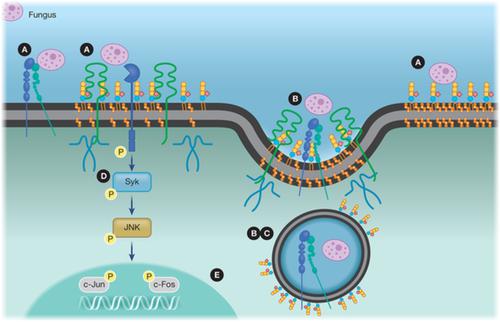当前位置:
X-MOL 学术
›
Cell. Microbiol.
›
论文详情
Our official English website, www.x-mol.net, welcomes your feedback! (Note: you will need to create a separate account there.)
Host cell membrane microdomains and fungal infection
Cellular Microbiology ( IF 3.4 ) Pub Date : 2021-08-14 , DOI: 10.1111/cmi.13385 Taiane N Souza 1 , Alessandro F Valdez 1 , Juliana Rizzo 2 , Daniel Zamith-Miranda 3 , Allan Jefferson Guimarães 4 , Joshua D Nosanchuk 3 , Leonardo Nimrichter 1
Cellular Microbiology ( IF 3.4 ) Pub Date : 2021-08-14 , DOI: 10.1111/cmi.13385 Taiane N Souza 1 , Alessandro F Valdez 1 , Juliana Rizzo 2 , Daniel Zamith-Miranda 3 , Allan Jefferson Guimarães 4 , Joshua D Nosanchuk 3 , Leonardo Nimrichter 1
Affiliation

|
Lipid microdomains or lipid rafts are dynamic and tightly ordered regions of the plasma membrane. In mammalian cells, they are enriched in cholesterol, glycosphingolipids, Glycosylphosphatidylinositol-anchored and signalling-related proteins. Several studies have suggested that mammalian pattern recognition receptors are concentrated or recruited to lipid domains during host-pathogen association to enhance the effectiveness of host effector processes. However, pathogens have also evolved strategies to exploit these domains to invade cells and survive. In fungal organisms, a complex cell wall network usually mediates the first contact with the host cells. This cell wall may contain virulence factors that interfere with the host membrane microdomains dynamics, potentially impacting the infection outcome. Indeed, the microdomain disruption can dampen fungus-host cell adhesion, phagocytosis and cellular immune responses. Here, we provide an overview of regulatory strategies employed by pathogenic fungi to engage with and potentially subvert the lipid microdomains of host cells.
中文翻译:

宿主细胞膜微区与真菌感染
脂质微域或脂筏是质膜的动态且紧密有序的区域。在哺乳动物细胞中,它们富含胆固醇、鞘糖脂、糖基磷脂酰肌醇锚定蛋白和信号相关蛋白。几项研究表明,哺乳动物模式识别受体在宿主-病原体关联期间被集中或募集到脂质结构域,以增强宿主效应过程的有效性。然而,病原体也进化出了利用这些结构域侵入细胞并生存的策略。在真菌生物中,复杂的细胞壁网络通常介导与宿主细胞的首次接触。该细胞壁可能含有干扰宿主膜微域动力学的毒力因子,可能影响感染结果。事实上,微区破坏可以抑制真菌-宿主细胞的粘附、吞噬作用和细胞免疫反应。在这里,我们概述了病原真菌用于参与并可能破坏宿主细胞脂质微结构域的调控策略。
更新日期:2021-08-14
中文翻译:

宿主细胞膜微区与真菌感染
脂质微域或脂筏是质膜的动态且紧密有序的区域。在哺乳动物细胞中,它们富含胆固醇、鞘糖脂、糖基磷脂酰肌醇锚定蛋白和信号相关蛋白。几项研究表明,哺乳动物模式识别受体在宿主-病原体关联期间被集中或募集到脂质结构域,以增强宿主效应过程的有效性。然而,病原体也进化出了利用这些结构域侵入细胞并生存的策略。在真菌生物中,复杂的细胞壁网络通常介导与宿主细胞的首次接触。该细胞壁可能含有干扰宿主膜微域动力学的毒力因子,可能影响感染结果。事实上,微区破坏可以抑制真菌-宿主细胞的粘附、吞噬作用和细胞免疫反应。在这里,我们概述了病原真菌用于参与并可能破坏宿主细胞脂质微结构域的调控策略。



























 京公网安备 11010802027423号
京公网安备 11010802027423号